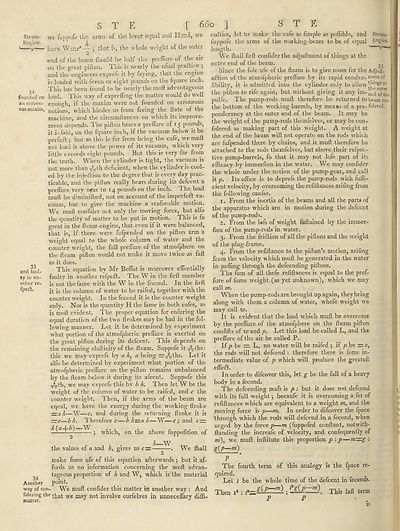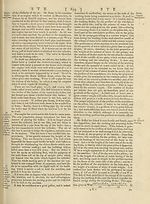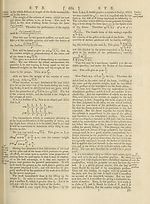Encyclopaedia Britannica, or, a Dictionary of arts, sciences, and miscellaneous literature : enlarged and improved. Illustrated with nearly six hundred engravings > Volume 19, Scripture-SUG
(712) Page 660 - STE
Download files
Complete book:
Individual page:
Thumbnail gallery: Grid view | List view

32
founded on
an errone-
S T E [
we fuppofe the arms of the lever eefual and we
^1 h
have W—c1— j that is, the whole weight of the outer
2- .
end of the beam fliould be half the preffure of the air
on the great pifton. This is nearly the ufual prabtice ;
and the engineers exprefs it by faying, that the engine
is loaded with feven or eight pounds on the fquare inch.
This has been found to be nearly the moft advantageous
load. This way of expreffing the matter would do well
enough, if the maxim were not founded on erroneous
ous maxim, noti0ns, which hinder us from feeing the date of the
machine, and the circumftances on which its improve¬
ment depends. The pifton bears a preflure of 15 pounds,
it is faid, on the fquare inch, if the vacuum below it be
perfect •, but as this is far from being the cafe, we muft
not load it above the power of its vacuum, which very
little exceeds eight pounds. But this is very far from
the truth. When the cylinder is tight, the vacuum is
not more than -^th deficient, when the cylinder is cool¬
ed by the injedtion to the degree that is every day prac¬
ticable, and the pifton really bears during its defcent a
preflure very nfar to 14 pounds on the inch. The load
muft be diminifhed, not on account of the imperfedl va¬
cuum, but to give the machine a reafonable motion.
We muft confider not only the moving force, but alfo
the quantity of matter to be put in motion. This is fo
great in the fteam-engine, that even if it were balanced,
that is, if there were fufpended on the pifton arm a
weight equal to the whole column of water and the
counter weight, the full preflure of the atmofphere on
the fteam pifton would not make it move twice as faft
as it does.
This equation by Mr Boflut is moreover eflentially
faulty in another refpedl. The W in the firft member
is not the fame-with the W in the fecond. In the firft
it is the column of water to be raifed, together with the
counter weight. In the fecond it is the counter weight
only. Nor is the quantity H the fame in both cafes, as
is moft evident. The proper equation for enfuring the
equal duration of the two ftrokes may be had in the fol¬
lowing manner. Let it be determined by experiment
what portion of the atmofpheric preflure is exerted on
the great piflon during its defcent. This depends on
the remaining elafticity of the fteam. Suppofe it T^ths:
this we may exprefs by a a being =rT^-ths. Let it
alfo be determined by experiment what portion of the
atmofpheric preflure on the pifton remains unbalanced
by the fteam below it during its afeent. Suppofe this
-j%th, we may exprefs this by b h. Then let W be the
weight of the column of water to be raifed, and c the
counter weight. Then, if the arms of the beam are
equal, we have the energy during the working ftroke
—ah—W—c, and during the returning ftroke it is
~c—bh. Therefore <7—b h^za h—W—c; and c~
——5 which, on the above fuppofition of
33
and laul-
ty in an¬
other re-
fpe<ft.
the values of a and b, gives us err
//—W
We lhall
make fome ufe of this equation afterwards *, but it af¬
fords us no information concerning the mod; advan¬
tageous proportion of //and W, which is the material
point.
way of con- We muft confider this matter in another way : And
fidermg the -we may not involve ourfelves in unneceifary diffi-
malter. ^
34
Another
Steam-
Engine,
3S
660 ] S T E
e culties, let us make the cafe as Ample as poffible, and
fuppofe the arms of the working-beam to be of equal
length.
We ftiall firft confider the adjuftment of things at the
outer end of the beam.
Since the foie ufe of the fteam is to give room for the Adjuft-
a ft ion of the atmofpheric preflure by its rapid conden- ment of
Ability, it is admitted into the cylinder only to allow ^''^s at
the pifton to rife again, but without giving it any im- end
pulfe. The pump-rods muft therefore be returned to beam con
the bottom of the working barrels, by means of a pre- fidered.
ponderancy at the outer end of the beam. It may be
the weight of the pump-rods themfelves, or may be con-
fidered as making part of this weight. A weight at
the end of the beam will not operate on the rods which
are fufpended there by chains, and it muft therefore bo
attached to the rods themfelves, but above their refpec-
tive pump-barrels, fo that it may not lofe part of its
efficacy by immerfion in the water. We may confider
the whole under the notion of the pump-gear, and call
it p. Its office is to deprefs the pump-rods with fuffi-
cient velocity, by overcoming the refiftances arifing from
the following caufes.
1. From the inertia of the beams and all the part* of
the apparatus which are in motion during the defcent
of the pump-rods.
2. From the l®fs of weight fuftained by the immer¬
fion of the pump-rods in water.
3. From the friftion of all the piftons and the weight
of the plug-frame.
4. From the refiftance to the pifton’s motion, arifing
from the velocity which muft be generated in the water
in paffing through the defeending piftons.
The fum of all thefe refiftances is equal to the pref¬
fure of fome weight (as yet unknown), which we may
call m.
When the pump-rods are brought up again, they bring
along with them a column of water, whofe weight we
may call w.
It is evident that the load which muft be overcome
by the preflure of the atmofphere on the fteani pifton
confifts of w and p. Let this load be called L, and the
preflure of the air be called P.
If jo be zr L, no water will be raifed •, if jo be r= 0,
the rods will not defeend : therefore there is fome in¬
termediate value of jo which will produce the greateft
effe£I.
In order to difeover this, let g be the fall of a heavy
body in a fecond.
The defeending mafs is p : but it does not defeend
with its full weight \ becaufe it is overcoming a fet of
refiftances which are equivalent to a weight m, and the
moving force is p—m. In order to difeover the fpace
through which the rods will defeend in a fecond, when
urged by the force jo—m (fuppofed conftant, notwith-
ftanding the increafe of velocity, and confequently of
w), wTe muft inftitute this proportion p : p—m—g :
gjP—™)
P
The fourth term of this analogy is the fpace re¬
quired.
Let t be the whole time of the defcent in feconds.
m) _ t*g(p r/i)
Then i*
P
P
This laft term
founded on
an errone-
S T E [
we fuppofe the arms of the lever eefual and we
^1 h
have W—c1— j that is, the whole weight of the outer
2- .
end of the beam fliould be half the preffure of the air
on the great pifton. This is nearly the ufual prabtice ;
and the engineers exprefs it by faying, that the engine
is loaded with feven or eight pounds on the fquare inch.
This has been found to be nearly the moft advantageous
load. This way of expreffing the matter would do well
enough, if the maxim were not founded on erroneous
ous maxim, noti0ns, which hinder us from feeing the date of the
machine, and the circumftances on which its improve¬
ment depends. The pifton bears a preflure of 15 pounds,
it is faid, on the fquare inch, if the vacuum below it be
perfect •, but as this is far from being the cafe, we muft
not load it above the power of its vacuum, which very
little exceeds eight pounds. But this is very far from
the truth. When the cylinder is tight, the vacuum is
not more than -^th deficient, when the cylinder is cool¬
ed by the injedtion to the degree that is every day prac¬
ticable, and the pifton really bears during its defcent a
preflure very nfar to 14 pounds on the inch. The load
muft be diminifhed, not on account of the imperfedl va¬
cuum, but to give the machine a reafonable motion.
We muft confider not only the moving force, but alfo
the quantity of matter to be put in motion. This is fo
great in the fteam-engine, that even if it were balanced,
that is, if there were fufpended on the pifton arm a
weight equal to the whole column of water and the
counter weight, the full preflure of the atmofphere on
the fteam pifton would not make it move twice as faft
as it does.
This equation by Mr Boflut is moreover eflentially
faulty in another refpedl. The W in the firft member
is not the fame-with the W in the fecond. In the firft
it is the column of water to be raifed, together with the
counter weight. In the fecond it is the counter weight
only. Nor is the quantity H the fame in both cafes, as
is moft evident. The proper equation for enfuring the
equal duration of the two ftrokes may be had in the fol¬
lowing manner. Let it be determined by experiment
what portion of the atmofpheric preflure is exerted on
the great piflon during its defcent. This depends on
the remaining elafticity of the fteam. Suppofe it T^ths:
this we may exprefs by a a being =rT^-ths. Let it
alfo be determined by experiment what portion of the
atmofpheric preflure on the pifton remains unbalanced
by the fteam below it during its afeent. Suppofe this
-j%th, we may exprefs this by b h. Then let W be the
weight of the column of water to be raifed, and c the
counter weight. Then, if the arms of the beam are
equal, we have the energy during the working ftroke
—ah—W—c, and during the returning ftroke it is
~c—bh. Therefore <7—b h^za h—W—c; and c~
——5 which, on the above fuppofition of
33
and laul-
ty in an¬
other re-
fpe<ft.
the values of a and b, gives us err
//—W
We lhall
make fome ufe of this equation afterwards *, but it af¬
fords us no information concerning the mod; advan¬
tageous proportion of //and W, which is the material
point.
way of con- We muft confider this matter in another way : And
fidermg the -we may not involve ourfelves in unneceifary diffi-
malter. ^
34
Another
Steam-
Engine,
3S
660 ] S T E
e culties, let us make the cafe as Ample as poffible, and
fuppofe the arms of the working-beam to be of equal
length.
We ftiall firft confider the adjuftment of things at the
outer end of the beam.
Since the foie ufe of the fteam is to give room for the Adjuft-
a ft ion of the atmofpheric preflure by its rapid conden- ment of
Ability, it is admitted into the cylinder only to allow ^''^s at
the pifton to rife again, but without giving it any im- end
pulfe. The pump-rods muft therefore be returned to beam con
the bottom of the working barrels, by means of a pre- fidered.
ponderancy at the outer end of the beam. It may be
the weight of the pump-rods themfelves, or may be con-
fidered as making part of this weight. A weight at
the end of the beam will not operate on the rods which
are fufpended there by chains, and it muft therefore bo
attached to the rods themfelves, but above their refpec-
tive pump-barrels, fo that it may not lofe part of its
efficacy by immerfion in the water. We may confider
the whole under the notion of the pump-gear, and call
it p. Its office is to deprefs the pump-rods with fuffi-
cient velocity, by overcoming the refiftances arifing from
the following caufes.
1. From the inertia of the beams and all the part* of
the apparatus which are in motion during the defcent
of the pump-rods.
2. From the l®fs of weight fuftained by the immer¬
fion of the pump-rods in water.
3. From the friftion of all the piftons and the weight
of the plug-frame.
4. From the refiftance to the pifton’s motion, arifing
from the velocity which muft be generated in the water
in paffing through the defeending piftons.
The fum of all thefe refiftances is equal to the pref¬
fure of fome weight (as yet unknown), which we may
call m.
When the pump-rods are brought up again, they bring
along with them a column of water, whofe weight we
may call w.
It is evident that the load which muft be overcome
by the preflure of the atmofphere on the fteani pifton
confifts of w and p. Let this load be called L, and the
preflure of the air be called P.
If jo be zr L, no water will be raifed •, if jo be r= 0,
the rods will not defeend : therefore there is fome in¬
termediate value of jo which will produce the greateft
effe£I.
In order to difeover this, let g be the fall of a heavy
body in a fecond.
The defeending mafs is p : but it does not defeend
with its full weight \ becaufe it is overcoming a fet of
refiftances which are equivalent to a weight m, and the
moving force is p—m. In order to difeover the fpace
through which the rods will defeend in a fecond, when
urged by the force jo—m (fuppofed conftant, notwith-
ftanding the increafe of velocity, and confequently of
w), wTe muft inftitute this proportion p : p—m—g :
gjP—™)
P
The fourth term of this analogy is the fpace re¬
quired.
Let t be the whole time of the defcent in feconds.
m) _ t*g(p r/i)
Then i*
P
P
This laft term
Set display mode to:
![]() Universal Viewer |
Universal Viewer | ![]() Mirador |
Large image | Transcription
Mirador |
Large image | Transcription
Images and transcriptions on this page, including medium image downloads, may be used under the Creative Commons Attribution 4.0 International Licence unless otherwise stated. ![]()
| Permanent URL | https://digital.nls.uk/192704538 |
|---|
| Attribution and copyright: |
|
|---|
| Description | Ten editions of 'Encyclopaedia Britannica', issued from 1768-1903, in 231 volumes. Originally issued in 100 weekly parts (3 volumes) between 1768 and 1771 by publishers: Colin Macfarquhar and Andrew Bell (Edinburgh); editor: William Smellie: engraver: Andrew Bell. Expanded editions in the 19th century featured more volumes and contributions from leading experts in their fields. Managed and published in Edinburgh up to the 9th edition (25 volumes, from 1875-1889); the 10th edition (1902-1903) re-issued the 9th edition, with 11 supplementary volumes. |
|---|---|
| Additional NLS resources: |
|

